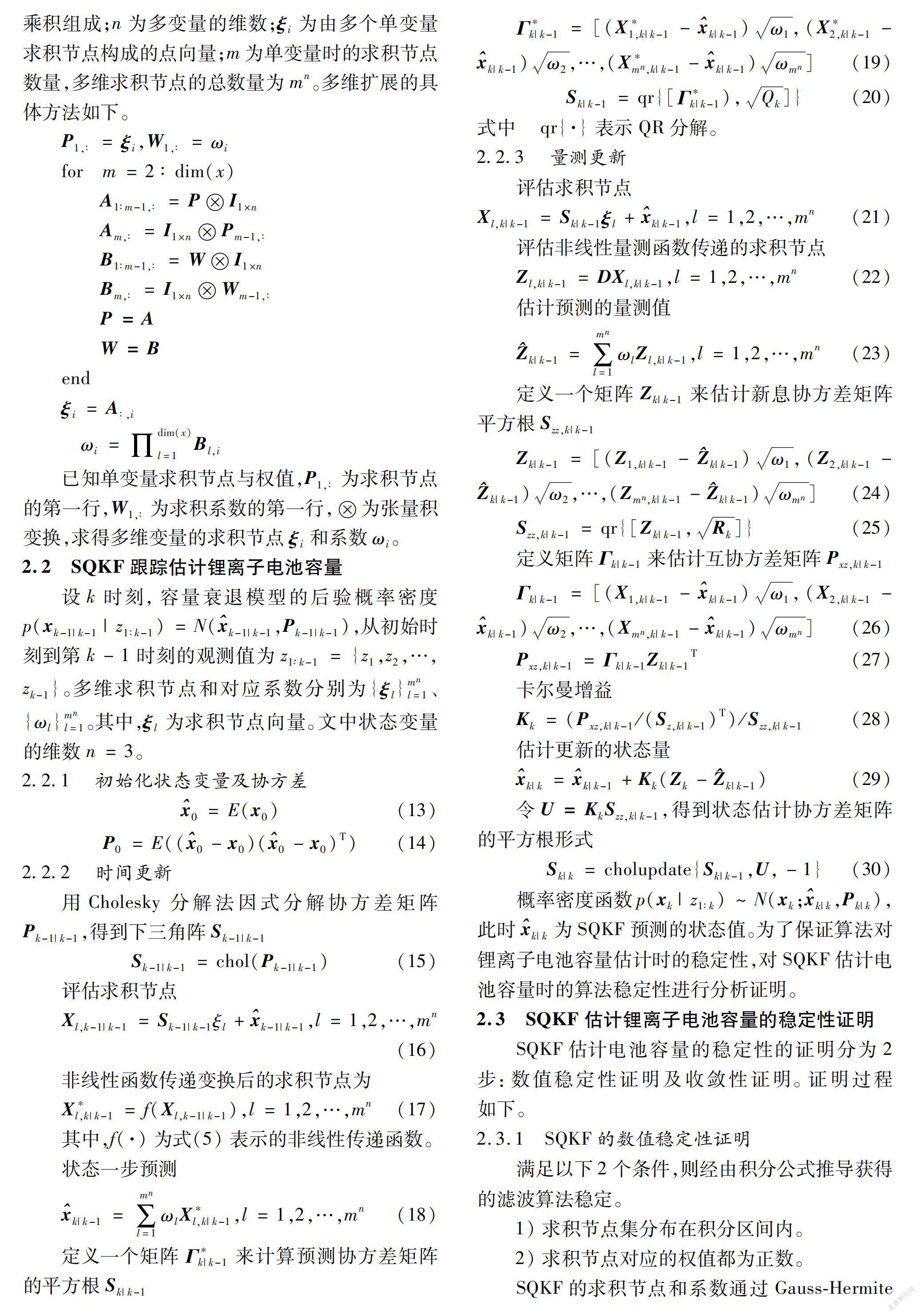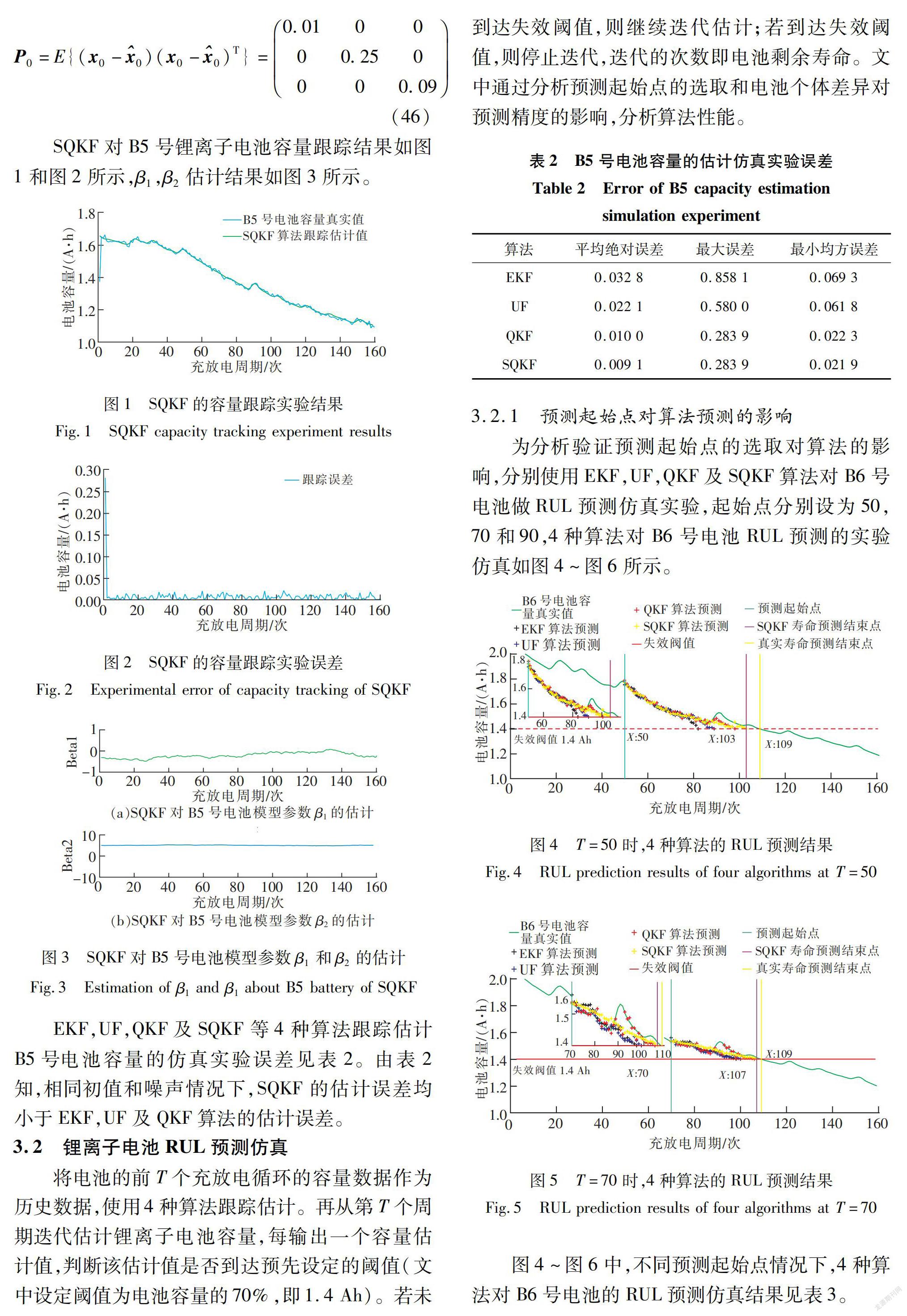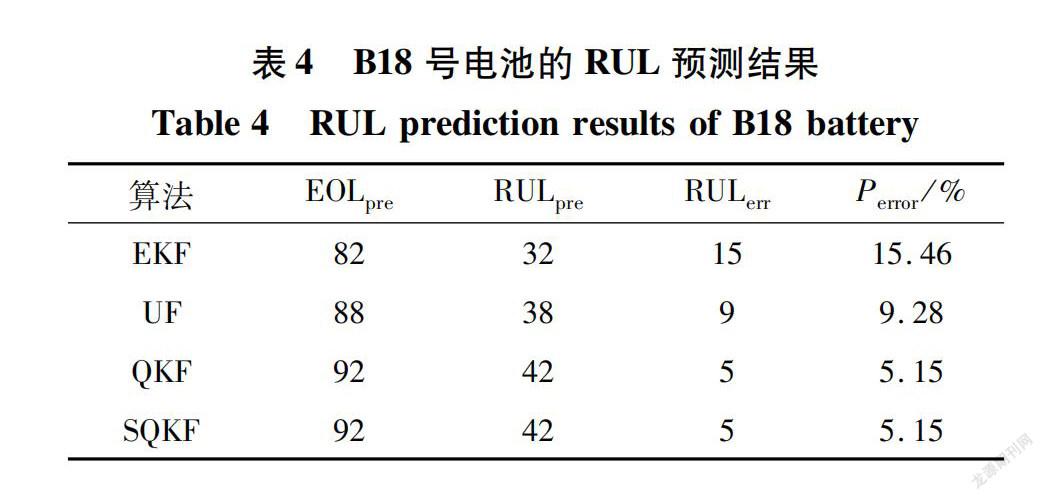基于SQKF的锂离子电池剩余寿命预测
2022-11-03黄梦涛胡礼芳张齐波
黄梦涛 胡礼芳 张齐波







摘 要:针对锂离子电池剩余寿命(remaining useful life,RUL)难以精准预测的问题,建立单指数经验容量衰退模型,提出能够有效解决电池非线性问题的平方根求积分卡尔曼滤波(square-root quadrature kalman filtering,SQKF)算法。现有的最优估计方法中,求积分卡尔曼滤波(quadrature kalman filtering,QKF)是一种高精度采样算法。研究发现,QKF的估计误差易引起非对称、非正定协方差的传播,影响算法稳定性。在QKF算法上进行平方根扩展,并对单变量求积节点进行多维扩展,将SQKF算法应用于电池容量跟踪估计;另外,从理论上证明SQKF的稳定性。使用NASA公开数据集对算法进行仿真验证,并与现有的扩展卡尔曼滤波、无迹滤波、QKF算法对比。结果表明,在一定条件下,SQKF的RUL预测误差在6%以内,数值精度以及数值稳定性有很大提高,并且研究发现SQKF受锂离子电池个体差异性的影响较小,文中方法在锂离子电池RUL预测的实际应用方面具有参考价值。
关键词:锂离子电池;剩余使用寿命;经验容量衰退模型;平方根求积分卡尔曼滤波
中图分类号:TP 391.9
文献标志码:A
文章编号:1672-9315(2022)05-0994-09
DOI:10.13800/j.cnki.xakjdxxb.2022.0519开放科学(资源服务)标识码(OSID):
Square-root quadrature Kalman filtering for remaining useful life prediction in lithium-ion battery
HUANG Mengtao,HU Lifang,ZHANG Qibo
(College of Electrical and Control Engineering,Xi’an University of Science and Technology,Xi’an 710054,China)
Abstract:In order to improve the prediction accuracy of Remaining Useful Life(RUL)of lithium-ion battery,a single-exponential empirical capacity degradation model is established,and a Square-Root Quadrature Kalman Filtering(SQKF)algorithm is proposed to solve the nonlinear estimation problem of battery.Among the existing optimal estimation methods,Quadrature Kalman Filtering(QKF)is a high-precision sampling algorithm.According to the researches,the estimation error of QKF tends of trigger the propagation of asymmetric and non-positive covariance,which affects the stability of the algorithm.In this paper,the square root extension is carried out on QKF,the multi-dimensional extension of the univariate integral point is accomplished,and SQKF is applied to battery capacity tracking estimation.Meanwhile,the stability of the approach is theoretically proved.The algorithm is simulated and verified using NASA’s public dataset,and compared with Extended Kalman Filtering,Unscented Filtering,and QKF.The results show that under certain conditions,the prediction error of SQKF on RUL is within 6%,both the numerical accuracy and stability are greatly improved,and SQKF is less affected by the individual differences of lithium-ion batteries.SQKF has reference value in the practical application of RUL prediction for lithium-ion battery.
Key words:lithium-ion battery;remaining useful life;empirical capacity degradation model;square-root quadrature Kalman filtering
0 引 言
近年來,新能源汽车凭借节能、低排放、经济等优势,迅速占据汽车市场。锂离子电池作为新能源汽车的主要动力源,随着充放电循环次数的增加,电池容量会不同程度的衰退,导致电池使用寿命缩短,电池性能退化。锂离子电池剩余寿命(remaining useful life,RUL)的精准预测,对于电池状态估计、预测性维护、自主健康管理具有重大意义,对保证新能源汽车安全稳定运行起到重要作用。
目前,主流的鋰离子电池RUL预测方法分为
2类。一类是基于数据驱动的预测方法。使用锂离子电池全寿命周期的退化实验数据,利用机器学习算法运算,得出电池的退化状态。马里兰大学高级生命周期工程中心学者ZHANG等人使用弹性均方反向传播误差的方法自适应优化长短期记忆递归神经网络,并使用Dropout技术解决神经网络模型的过拟合问题。实验验证,该方法相对于传统的循环神经网络(recurrent neural network,RNN)可以更快速、更准确地预测出电池的RUL。徐东辉等提出一种非线性组合预测模型,将Elman神经网络和非线性自回归神经网络(nonlinear auto-regressive model with exogenous inputs,NARX)预测得到的电池性能退化特征量,用最小二乘支持向量机和RBF神经网络进行非线性组合,预测电池的RUL。实验结果表明,2种方法的预测精度均比单一化的Elman神经网络和NARX神经网络精度高。马里兰大学HU等将递归神经网络、支持向量机、相关向量机、贝叶斯线性回归模型等方法进行加权组合,发现加权组合的数据驱动方法预测精度高于单一的数据驱动预测方法的精度。
另一类是基于机理模型的预测方法。通过建立机理模型来表征锂离子电池的容量退化过程,再使用基于Bayesian估计的滤波方法精确估计电池的退化状态。同济大学DAI等在Thevenin模型上增加一个RC回路(极化电阻和极化电容并联组成一个RC回路)组成等效电路模型,在线辨识模型参数,完成RUL预测。但在近似过程中,电池内部参量之间的一些重要隐含关系易被忽略,等效电路模型难以完全考虑复杂的外界条件,模型对电池的动、静态特性描述较弱。马里兰大学高级生命周期工程中心HE等使用大量退化实验数据,建立双指数经验容量衰退模型,使用粒子滤波算法辨识模型参数,并不断更新参数,实现RUL估计。美国国家航空航天局艾姆斯研究中心的SAHA等通过电池的集中参数模型建立单指数经验容量衰退模型,使用粒子滤波算法有效地估计RUL。
基于电池经验容量衰退模型的预测方法依据动力电池参数之间的关联性建立模型,模型的适用性强,易于获取。文中采用基于电池的经验容量衰退模型的方法预测锂离子电池的RUL,并设计平方根求积分卡尔曼滤波(square-root quadrature kalman filtering,SQKF)算法求解模型。
1 锂离子电池经验容量衰退模型建立
美国国家航空航天局(NASA)的一些学者研究发现,锂离子电池的电荷转移电阻与电解质电阻之和与容量C具有线性关系。SAHA等据此提出一个能反映电池容量衰退过程的电池机理模型。模型考虑库伦效率对电池衰退的影响,也考虑电池静置引起的容量再生,模型见式(1)。
C=ηC+βexp(-β/Δt) (1)
式中 k为周期索引,代表第k次充放电周期;Ck表示第k个充放电周期的放电容量;η为库伦效率;Δtk-1为第k-1个充放电周期到第k个充放电周期的休息时间。β1和β2为待确定参数,受温度、电流倍率等因素影响,文中采用模型状态扩张的方法将未知参数辨识问题转为估计问题。为模拟外界干扰对模型的影响,引入系统误差和测量误差。采用如下方程描述β1,β2以及Ck的变化。
4 结 论
1)单指数经验容量衰退模型适合描述锂离子电池的容量衰退过程。
2)SQKF估计锂离子电池容量的过程稳定。
3)在不同预测起始点下,SQKF的精准度均高于EKF,UF,QKF。
4)相比于EKF,UF,QKF,SQKF预测算法的精度受电池个体差异影响较小,稳定性好。
5)基于单指数经验容量衰退模型的SQKF算法为RUL预测提供了一个良好的选择,若进一步考虑电池寿命和工作环境温度的关系,可以提高算法的适用性和精确性。
参考文献(References):
[1]马宪民.电动汽车高频交流功率分布系统的谐波分析[J].西安科技大学学报,2001,21(2):145-147,151.
MA Xianmin.Harmonic analysis of high frequency AC power distribution system in electric vehicle[J].Journal of Xi’an University of Science and Technology,2001,21(2):145-147,151.
[2]YANG J,XIA B,HUANG W,et al.Online state-of-health estimation for lithium-ion batteries using constant-voltage charging current analysis[J].Applied Energy,2018,212(15):1589-1600.
[3]WANG Y,TIAN J,SUN Z,et al.A comprehensive review of battery modeling and state estimation approaches for advanced battery management systems[J].Renewable and Sustainable Energy Reviews,2020(131):110015-110033.
[4]HASIB S A,ISLAM S,CHAKRABORTTY R K,et al.A comprehensive review of available battery datasets,RUL prediction approaches,and advanced battery management[J].IEEE Access,2021(9):86166-86193.
[5]王常虹,董漢城,凌明祥,等.车用锂离子电池剩余使用寿命预测方法[J].汽车工程,2015,37(4):476-479.WNG Changhong,DONG Hancheng,LING Mingxiang,et al.Remaining useful life prediction of automotive lithium-ion battery[J].Automotive Engineering,2015,37(4):476-479.
[6]JIN S,SUI X,HUANG X,et al.Overview of machine learning methods for lithium-ion battery remaining useful lifetime prediction[J].Electronics,2021(10):3126-3144.
[7]WEI J,DONG G,CHEN Z.Remaining useful life prediction and state of health diagnosis for lithium-ion batteries using particle filter and support vector regression[J].IEEE Transactions on Industrial Electronics,2018,65(7):5634-5643.
[8]ZHANG Y,XIONG R,HE H,et al.Long short-term memory recurrent neural network for remaining useful life prediction of lithium-ion batteries[J].IEEE Transactions on Vehicular Technology,2018,67(7):5695-5705.
[9]徐东辉.车用锂离子动力电池剩余寿命非线性组合预测研究[J].北京师范大学学报:自然科学版,2021,57(5):571-576.XU Donghui.Nonlinear combination prediction of remaining useful life of automotive lithium-ion batteries[J].Journal of Beijing Normal University(Natural Science),2021,57(5):571-576.
[10]HU C,YOUN B D,WANG P,et al.Ensemble of data-driven prognostic algorithms for robust prediction of remaining useful life[J].Reliability Engineering and System Safety,2012(103):120-135.
[11]蔡艳平,陈万,苏延召,等.锂离子电池剩余寿命预测方法综述[J].电源技术,2021,45(5):678-682.CAI Yanping,CHEN Wan,SU Yanzhao,et al.Review of remaining useful life prediction for lithium ion batteries[J].Chinese Journal of Power Sources,2021,45(5):678-682.
[12]刘月峰,张公,张晨荣,等.锂离子电池RUL预测方法综述[J].计算机工程,2020,46(4):11-18.LIU Yuefeng,ZHANG Gong,ZHANG Chenrong,et al.Review of RUL prediction method for lithium-ion batteries[J].Computer Engineering,2020,46(4):11-18.
[13]DAI H,WEI X,SUN Z.A new SOH prediction concept for the power lithium-ion battery used on HEVs[C]//IEEE Vehicle Power and Propulsion Conference.Washington,USA:IEEE Computer Society,2009:1649-1653.
[14]HE W,WILLIARD N,OSTERMAN M,et al.Prognostics of lithium-ion batteries based on dempster-shafer theory and the Bayesian Monte Carlo method[J].Journal of Power Sources,2011,196(23):10314-10321.
[15]SAHA B,GOEBEL K.Modeling Li-ion battery capacity depletion in a particle filtering framework[C]//Annual Conference of the Prognostics and Health Management Society.San Diego,CA,USA:Prognostics and Health Management Society,2009:1-10.[16]
ITO K.Gaussian filters for nonlinear filtering problems[J].IEEE Transactions on Automatic Control,2000,45(5):910-927.
[17]丁勁涛,罗美君,呙晓兵,等.航空锂离子电池剩余容量及RUL预测建模[J].电池,2019,49(4):329-333.DING Jintao,LUO Meijun,GUO Xiaobing,et al.Available capacity and RUL prediction model for aviation Li-ion battery[J].Battery,2019,49(4):329-333.
[18]HUANG M,ZHANG Q.Prediction of remaining useful life of lithium-ion ba-ttery based on UKF[C]//China Automation Congress.Shanghai,China:Institute of Electrical and Electronics Engineers Inc.,2020:4502-4506.
[19]冉昌艳,程向红,王海鹏.基于Gauss-Hermite求积分卡尔曼滤波的SINS非线性初始对准方法[J].东南大学学报(自然科学版),2014,44(2):266-271.RAN Changyan,CHENG Xianghong,WANG Haipeng.SINS nonlinear initial alignment using Gauss-Hermite quadrature Kalman filter[J].Journal of Southeast University(Natural Science Edition),2014,44(2):266-271.
[20]巫春玲,韩崇昭.平方根求积分卡尔曼滤波器[J].电子学报,2009,39(12):1826-1839.WU Chunling,HAN Chongzhao.Square-root quadrature Kalman filter[J].Acta Electronica Sinica,2009,39(12):1826-1839.
[21]ARASARATNAM I,HAYKIN S,ELLIOTT R J.Discrete-time nonlinear filtering algorithms using Gauss-Hermite quadrature[J].Proceedings of the IEEE,2007,95(5):953-977.
[22]ZHOU J,JIAN W.An estimation strategy of lithium battery SOC based on Gauss-Hermite filter[J].Applied Mechanics & Materials,2014,492:147-150.
[23]HUANG M,WANG C,LIU B,et al.Quadrature Kalman filter based on state of charge estimation for lithium-ion battery[J].Advances in Mechanical Engineering,2020,12(7):1-10.
[24]XIONG K,ZHANG H,CHAN C.Performance evaluation of UKF-based nonlinear filtering[J].Automatica,2006,42(2):261-270.
[25]BOLE B,KULKARNI C S,DAIGLE M J.Adaptation of an electrochemistry-based Li-ion battery model to account for deterioration observed under randomized use[C]//Conference of the Prognostics & Health Management Society.Fort Worth,TX,USA:Prognostics and Health Management Society,2014:502-510.
